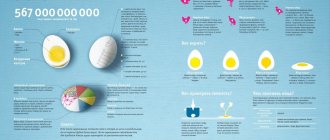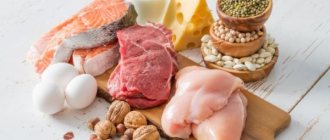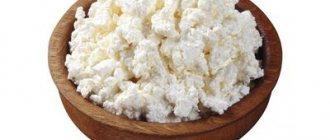What are the benefits of egg white? How much is there in one egg? Is the yolk harmful? What is the best way to prepare this product? Long before the abundance of sports proteins, ordinary chicken eggs were an indispensable source of protein for athletes. Neither meat, nor fish, nor even the revered chicken could provide what the athlete received from proteins and yolks. It is not surprising that since then millions of people have been asking the following questions: how much protein is in one egg, how to cook them correctly, are yolks harmful, etc.
With all the information, you can skillfully include the most easily digestible source of natural protein in your diet, compensating for the lack of proteins without risk to health. But to do this, you need to know not only how many grams of protein are in 1 egg, but also the answers to some other questions.
How does a chicken egg work?
This is a useful and popular product because it includes a full set of essential amino acids, vitamins, and mineral compounds. Its structure is as follows:
- Shell. It is durable, but has pores for the exchange of air and moisture with the environment. Its thickness is from 0.3 to 1.6 mm. This is an inedible part for humans, which can be used to feed birds, as fertilizer and for decorative mosaics.
- Protein. The liquid part contains a lot of water (85%), it is denser in the middle. It forms two cords inside. It is separated from the shell by a pair of shells.
- Yolk. It is located in the middle of the protein. It concentrates half of the dry matter of the product with a predominance of proteins and lipids. Viscous, has a thin shell.
The size and weight, color and density of the shell, the shade of the yolk and its size greatly depend on the breed of chickens and the diet of their feed.
Interesting Facts
People have learned to domesticate chicken and obtain highly nutritious eggs from it since ancient times. Since then, many fairy tales, beliefs and rituals have been associated with its products. Here are some of the most interesting facts from the history of breeding this poultry.
- The weight of one egg laid by a meat breed varies from 50 to 65 g.
- Decorative breeds can make their clutches both medium-sized and very small. The Malaysian Serama has the smallest clutches, their weight barely exceeds 10 g, and the size is 1:5 to the usual one obtained from a domestic mongrel chicken.
- Gigantic achievements in this area have also been noted. Almost reaching the size of an ostrich, a Cuban laying hen laid an egg. It weighed about 1.5 kg.
- The harvest of English breeders was distinguished by its size. With a mass of 450 g per specimen, it reached 23 cm in diameter and 32 cm in length.

- The most yolks (as many as 5) in one shell were also recorded in England.
- The taste and mineral composition of the contents do not depend in any way on the color of the shell. The color depends only on the breed and color of the chicken’s earrings, and not at all on its nutrition or content. The most fertile hens are the ones whose eggshells are white, so these are the ones that can be found on sale most often.
- In America, a breed was bred with blue, green and yellow shell colors, but the mineral composition of the white and yolk is no different from ordinary white ones.
Daily intake of eggs

Opinions differ on this matter. American scientists urge you to eat no more than 3 eggs a week so as not to provoke an increase in cholesterol. According to other data, no more than 260 pieces should be consumed per year. (5 per week).
Most nutritionists believe that eating 1 pc. per day has a beneficial effect on health and does not cause harm. This norm is suitable for women and children, although quail is preferable for them (4-5 pieces per day), because they have a higher mineral content. For men and athletes, the quantity can be increased to 2 pcs. daily. Read more about the beneficial properties of eggs and contraindications for this product in the article.
Top 5 quality products based on the results of test purchases of Roskontrol
Having familiarized yourself with consumer opinion regarding the products of the segment in question, it would not hurt to study the verdicts of the independent examination of Roskontrol, which can tell much more useful information. It is important to remember that only laboratory testing can determine the true quality of any product, including chicken eggs.
Roscar Extra Omega-3 Active C0
Price – 99 rub. for 6 pcs.
The best, according to experts, are eggs of the highest category, the composition of which was recognized as completely safe, not including antibiotics, pathogenic microflora and GMOs. You can eat it raw, especially considering that eggs are rich in Omega-3 fatty acids, the volume of which fully corresponds to what is stated in the labeling.
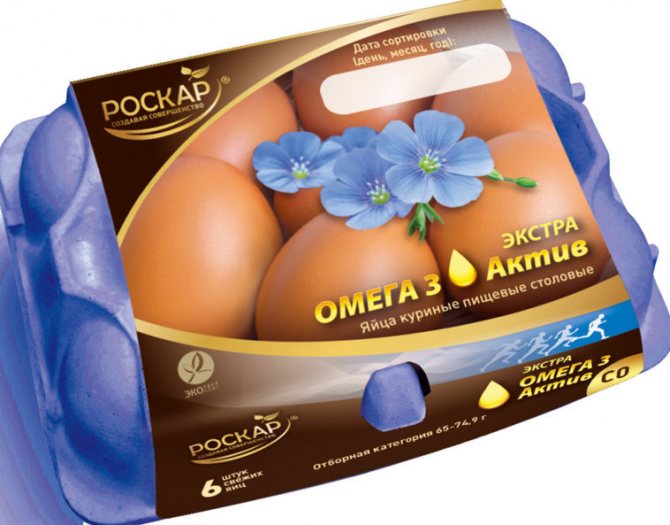
very tasty and healthy eggs, fully consistent with the characteristics indicated by the manufacturer himself;
always fresh, clean products;
The quality of the packaging is beyond praise.
exorbitant price.
Okskoye S1
Price – 73-110 rub. for 10 pcs.
Despite the fact that these are category 1 eggs, they were highly rated by the expert commission. Thus, among the numerous advantages of the product, experts noted the high degree of safety of eggs, in the composition of which it was not possible to identify even a hint of anything prohibited, excellent organoleptic properties and a relatively low height of the air chamber, if a comparative analogy is made with analogue samples from other manufacturers.
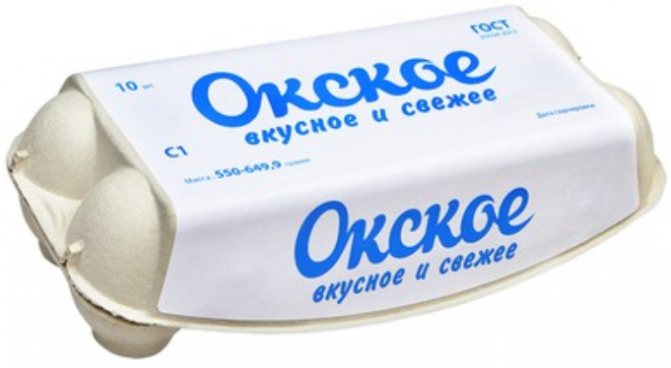
taste qualities;
safety;
indicators of taste and energy value;
size close to the upper threshold value.
not identified.
Roscar Activita, selenium + iodine, C0
Price – 97 rub. for 10 pcs.
Another high-quality eggs of the highest category, which received a high examination score, being recognized as tasty and completely safe, containing no antibiotics or pesticides.
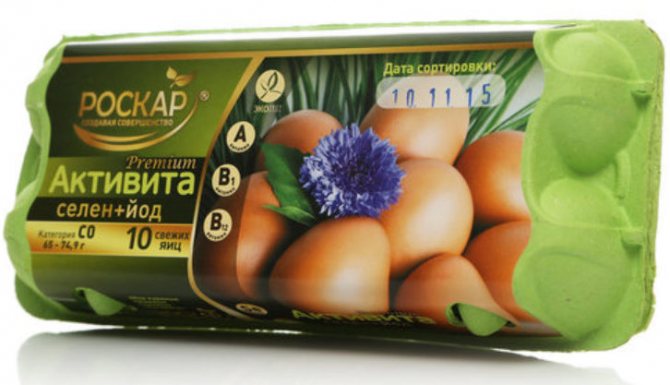
large fresh tasty eggs with good composition;
high content of useful chemical elements (selenium and iodine);
appearance and quality of packaging.
not the most affordable price tag.
Every day C0
Price – 44 rub. for 10 pcs.
If all the previous positions seem too expensive to you, then take a closer look at the “Every Day” eggs, which have rightfully become the most budget-friendly in the ranking. At the same time, this circumstance did not in any way affect the quality of the product, which overall satisfied the expert commission. Thus, eggs were recognized as safe, tasty and nutritious, since their yolk content was very high.

good taste characteristics;
the air chamber is smaller than many analogues;
very economical offer.
non-compliance of Omega-3 and Omega-6 indicators with current GOST;
there are specimens with shell notches;
Not the best quality packaging.
Categories of chicken eggs
There are dietary ones, which can be stored for no longer than 7 days (marked with the letter D) and table ones (C) with a more impressive shelf life. Depending on the size, according to GOST R 55502-2013, products are divided into categories:
| Category | Letter designation | Weight 1 piece, g |
| Higher | XL | 75 g or more |
| Selective | L | 65-74,9 |
| First | M | 55 to 64.9 |
| Second | S | 45-54,9 |
| Third | no designation | 35-44,9 |
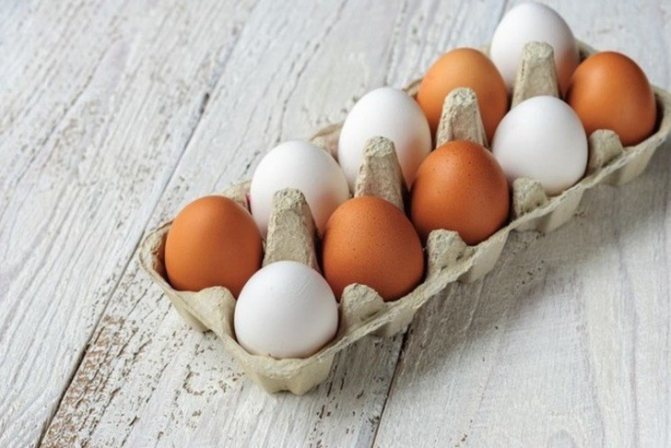
The price depends greatly on the category: the larger the product, the more expensive it is. But this has little effect on the nutritional value (the ratio of BJU and calorie content): 1 large or 2 small pieces provide the same benefits to the body.
Egg weight in grams by category
The category is determined by the mass of the egg: more than 75 grams belongs to the highest, 65-75 g - selected, 55-65 g - first, 45-55 g - second, 35-45 g - third. They are distinguished by markings on the shell: B - highest, O - selected, 1 - first, 2 - second, 3 - third.
Imported egg weight
But such marking is typical for a domestic manufacturer. Europe has its own labeling system, which provides detailed information about various aspects of the characteristics of a particular product. For example, about the method of keeping chickens: cage or free-range. The numbers also indicate the country of manufacture.
Imported eggs can weigh from 30 g to 73 g.
Each breed of chicken lays eggs of a size that is unique to it. Thus, the largest are given by representatives of the breed Hisex Brown - 71 g, Yurlovskaya - 70 g, Isa Brown - 63 g, approximately the same figures are given by Rhode Island, New Hampshire, Plymouth Rock, Moscow, Australorp, Russian Whites - about 60 g.
Egg composition: amount of protein, fat and carbohydrates
A chicken egg contains all the vital elements, but they are unevenly distributed between its parts. The most concentrated is the yolk. It contains more proteins and fat than protein, therefore its calorie content is higher. If we take it as a whole, then this animal product is practically devoid of carbohydrates (less than 1%). It includes 13-14% proteins and 11-12% lipids, has a calorie content of 163 kcal per 100 g.
Interesting
The energy value of ostrich eggs is lower than chicken eggs and is 118 kcal per 100 g, the protein content is only slightly less - 12.2%. Although the weight of one “ostrich gift” is 1.5-2 kg.
How much does the white and yolk of one egg weigh?
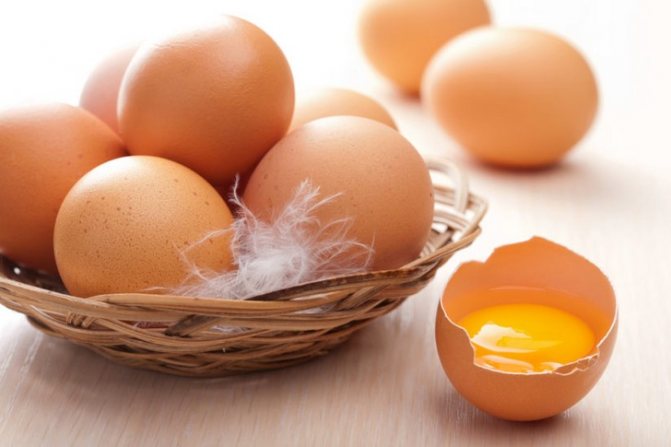
The weight of 1 piece is on average 60 g. Of this, the protein accounts for 56% or 33.6 g, the yolk accounts for 34% or 20.4 g. The exact values depend on the category of the product and, accordingly, its weight. For example:
- From 1 pc. of the highest category with a total mass of 75 g, you can get a white component of 42 g, a yellow component - 25.5 g.
- In 1 piece of the third category, weighing 35 g, the white accounts for 19.6 g, and the yolk 11.9 g.
Depending on the breed of chicken, the ratio of components varies within 1-1.5%.
How much protein is in one egg?
If we talk about the concentration of proteins in different parts of a raw egg, then the most of them are in the yolk - 17 percent. The whole product and its white part contain almost the same amount of amino acids - about 13%. At first glance, it is not entirely logical why white omelettes are more in demand on a diet. The thing is that the yolk contains a lot of fat and cholesterol, it is very high in calories. The table will tell you how many grams of protein are in one egg, as well as in its components.
Table: How much protein, fat and carbohydrates are in 1 EGG and in 100 g
| Proteins, g | Fats, g | Carbohydrates, g | Calorie content, kcal | |
| Whole, 100 g | 13,3 | 11,6 | 0,7 | 163 |
| Yolk, 100 g | 17,0 | 33,0 | 0,2 | 371 |
| Protein, 100 g | 13,0 | 0,3 | 0,7 | 54,4 |
| 1 piece weighing 60 g | 7,9 | 6,9 | 0,4 | 97,8 |
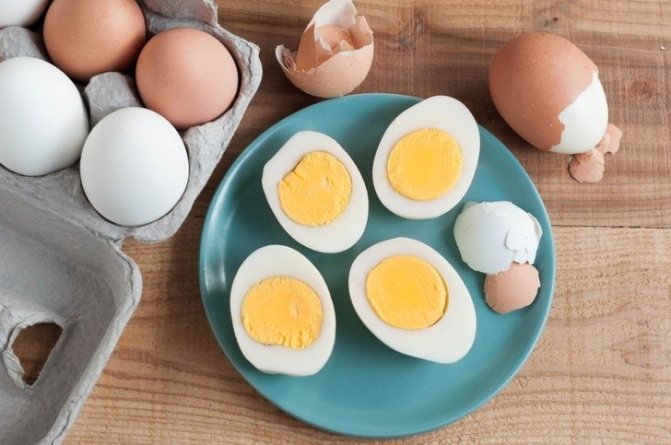
A boiled chicken egg is the best source of proteins in terms of their composition, set of amino acids, and is perfectly digestible. But in terms of concentration per 100 g, it is much inferior to other dietary products: veal, fish, shrimp, chicken breast.
The effect of heat treatment on the amount of protein
Cooking increases the absorption of animal products. Depending on the method of preparation, its chemical composition changes slightly (in terms of 100 g):
- A boiled egg contains 12.7 g of protein, and it doesn’t matter whether it’s soft-boiled or hard-boiled.
- In a fried egg without adding oil, due to the evaporation of moisture, the amino acid content will increase to 14.5 g.
- An omelet without added proteins contains 9.6 g.
- In fried eggs - 11.9 g.
The inclusion of milk, vegetables, herbs, bananas and other components in an omelet recipe greatly changes the KBJU of the dish.
What is the benefit of the product
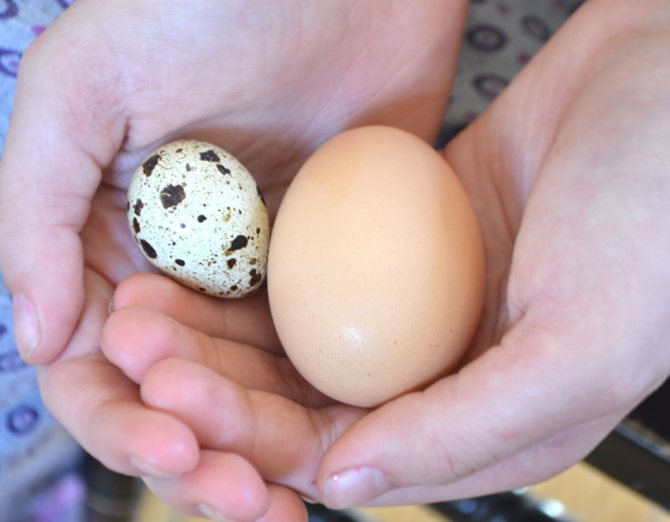
The chicken product is considered dietary and is included in the diet when recovering from serious illnesses and during weight loss. At the same time, most people wonder how many calories are in an egg if it helps with weight loss? There are few calories in it - one boiled unit is only 77 units.
But eggs contain many useful elements that are necessary for people on a diet. For example, choline, without which a person will have problems with the heart and brain function.
When losing weight, they are simply a godsend, because they allow you to keep your stomach full for a long time. This effect is especially visible if consumed for breakfast. Experts have noticed that if you eat a protein breakfast, your calorie intake decreases throughout the day. Microelements and substances are quickly and completely absorbed. This applies to the cooked version of the product, but not the raw version. One protein contains 13% protein, no more than 2% fat and carbohydrates, the rest is water. All components contain a rich composition of vitamins, the list of which includes B, E, D, A, as well as many minerals and enzymes.
Where is there more protein in chicken eggs or quail eggs?
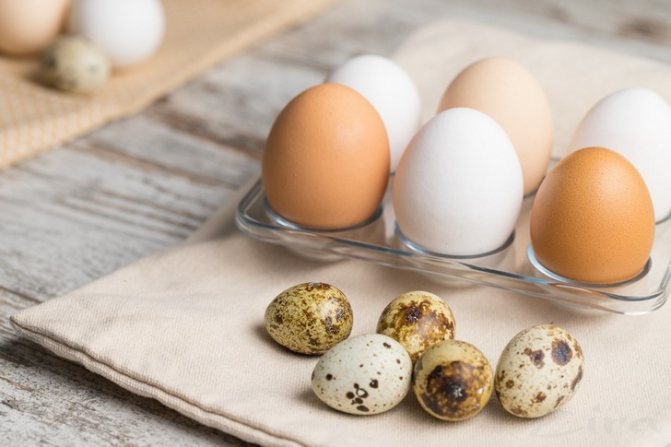
Quail eggs have their advantages: they do not contain salmonellosis, they are less likely to cause allergies, and contain more macro and microelements. But if we talk about the concentration of proteins, quail contains 11.9%, according to this indicator they are slightly inferior to chicken, they also have fewer calories (158 kcal per 100 g).
How much do the eggs of other birds weigh?
If you are wondering how much goose or quail eggs weigh in order to compare them with a chicken egg, then here is a small tablet just below. The weight, of course, is average.
| Type of eggs | Approximate weight of one piece |
| Quail eggs | 10-12 grams |
| Guinea fowl eggs | 25 grams |
| Chicken eggs | 50-55 grams |
| Pheasant eggs | 60 grams |
| Turkey eggs | 75 grams |
| Duck eggs | 90 grams |
| Goose eggs | 200 grams |
| Emu eggs | 780 grams |
| Ostrich eggs | 900 grams |
How long can egg whites be stored in the refrigerator?
The shell is a reliable barrier; it protects the contents from spoilage for 20 days without refrigeration. If the product is kept at a temperature of 0 to 5 degrees, then it can be consumed for 60 days. Separated egg whites are a different matter entirely. They can be stored in the refrigerator for no longer than 5 days in a closed jar. For longer storage, it is better to freeze them. True, in this case they partially lose their ability to whip into a fluffy foam.
The amount of protein in one egg is not the highest when compared to other animal products. But it is the most complete, including absolutely all essential amino acids. Because of this, steamed omelettes are allowed on all diets.
Raw and cooked
Those who follow diets are often interested in the question: how much does a boiled chicken egg weigh and is this indicator different from a raw one?
Since during the cooking process no significant processes of digestion, evaporation of moisture, or, conversely, saturation of the substance occur, the mass of one raw and cooked one is practically the same.
The only thing is that we always clean the shell before using it. It is by this value that a raw egg can differ from a boiled one.
Marking
Each egg sold in a store must have a certain marking on it. By marking you can determine freshness and size. The marking consists of two symbols, where the first symbol is the size of the egg, and the second is its freshness. Freshness comes in two types and is designated either by the letter D - a dietary egg laid no more than seven days ago. Or the letter C - a table egg laid more than seven days ago.
The following markings correspond to the sizes of eggs:
- B - highest category,
- O - selective category,
- 1 - first category,
- 2 - second category,
- 3 - third category.

